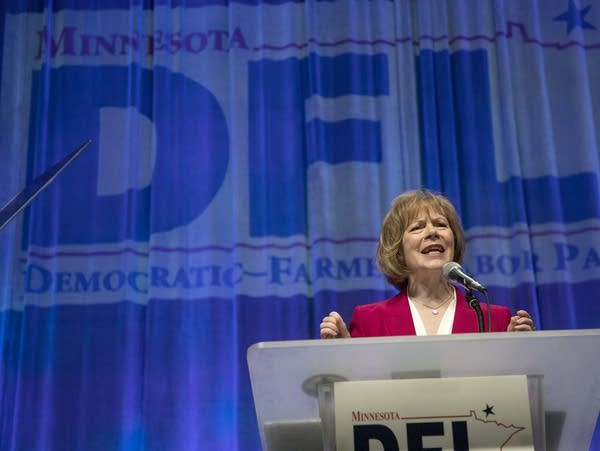Campaign fundraising ramped up in the third quarter of the year

DFL U.S. Sen. Tina Smith pulled in $1.3 million for her 2020 re-election bid between July and the end of September. Her best-known Republican opponent former U.S. Rep. Jason Lewis, who didn’t get into the race until late August, raised more than $413,000.

The money is already piling up in the Senate race more than a year before election day, according to third quarter campaign finance reports released this week. Smith has $2.7 million in total in the bank to spend on the race, while Lewis is holding on to more than $360,000.
And it’s just one of a handful of targeted races federal races in Minnesota next year, where several congressional districts are also in play. That includes the 2nd District, where DFL Rep. Angie Craig reported raising more than $500,000 during the third quarter with more than $1.1 million on hand.

She beat Lewis by more than 5 percentage points in 2018, but Republican groups are already spending on a digital ad buy highlighting her support of the ongoing impeachment inquiry against President Donald Trump. With Lewis running for the Senate, only one Republican has emerged so far to challenge her next year: Rick Olson, an attorney and former Michigan state lawmaker who now lives in Prior Lake. He’s raised $105,486 since entering the race on Sept. 3 and has $80,000 left to spend.
Create a More Connected Minnesota
MPR News is your trusted resource for the news you need. With your support, MPR News brings accessible, courageous journalism and authentic conversation to everyone - free of paywalls and barriers. Your gift makes a difference.
Another race already on national target lists is Minnesota’s southern 1st District, where freshman Republican Rep. Jim Hagedorn is facing a rematch against Democrat Dan Feehan. It was one of the closest races in the nation in 2018. Feehan entered the race after the third quarter deadline, but his campaign said he raised $100,000 within the first 24 hours of officially jumping in. Hagedorn reported raising $212,262 in the third quarter and has $459,005 left to spend. Another DFL candidate, farmer Ralph Kaehler, jumped into the race this week.
Republican groups are also expecting to spend more this cycle in the 7th District, where DFL Rep. Collin Peterson has served for 28 years, despite Trump winning in his district by more than 30 percentage points in 2016. Former Republican state Sen. and Lt. Gov. Michelle Fischbach raised $100,000 since jumping into the race on Sept. 3 and has $85,000 on hand.
Republican House Minority Leader Kevin McCarthy's Leadership PAC contributed the maximum $10,000 to her bid.
Another Republican candidate, Noel Collis, reported raising $135,800 in the third quarter with more than $128,000 on hand.
Peterson, who hasn’t announced whether he’s actually seeking re-election in the district yet, raised $159,000 in the third quarter and has more than $917,000 in the bank if he decides to run again.
Candidate fundraising represents just a fraction of the total spending expected in next year’s campaign. Outside spending groups flooded tens of millions into Minnesota in 2018 to influence four competitive congressional races and one for the U.S. Senate.
Some of the most expensive races last fall were Minnesota’s suburban 3rd District and northeastern 8th District, but some political analysts don’t expect outside groups to spend as much in those districts next fall.
In the suburbs, DFL Rep. Dean Phillips raised nearly $214,000 in the third quarter and has nearly $226,000 in the bank. His Republican opponent, Kendall Qualls, raised more than $93,000 in the third quarter and reported roughly $97,000 in the bank. It’s still a year away from election day, but Phillips spent more than $6 million in 2018 to defeat incumbent Republican Rep. Erik Paulsen, who spent more than $5 million on the race. Outside groups spent more than $10 million in that race.
It’s a similar story in the 8th District, where Republican Rep. Pete Stauber reported raising $222,013 with nearly $541,000 saved up for his re-election campaign. He has two announced challengers, DFLer Quinn Nystrom and Soren Sorenson, but neither has raised any money yet. Last year, Stauber spent $1.7 million to win the open seat but outside groups swamped the district with more than $9 million in spending, much of that against DFL opponent Joe Radinovich.
And some Minnesota races that aren’t expected to be competitive are still drawing in major cash. DFL U.S. Rep. Ilhan Omar, who represents the 5th District, announced raising more than $1.1 million between July and the end of September. It’s more than double what she raised in the second quarter of this year and an impressive haul considering her district, which covers Minneapolis and surrounding suburbs, is the most Democratic congressional seat in the state.
But there are still a number of Republicans challenging her next year, including Lacy Johnson, who reported raising $172,000 during the same time period with $33,000 on hand.
DFL Rep. Betty McCollum, who represents the 4th District, raised more than $125,000 and has more than $245,005 on hand. Two challengers against her have not reported raising any money yet.
Republican Rep. Tom Emmer, who represents the conservative 6th District and also serves as the National Republican Congressional Committee chair, raised $370,000 and has more than $730,000 on hand. He has two DFL challengers, including Ian Todd, who ran in 2018, and Tawnja Zahradka, who announced her campaign this week.